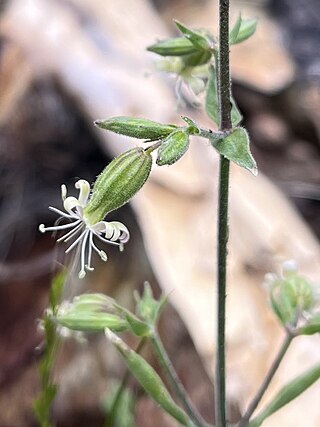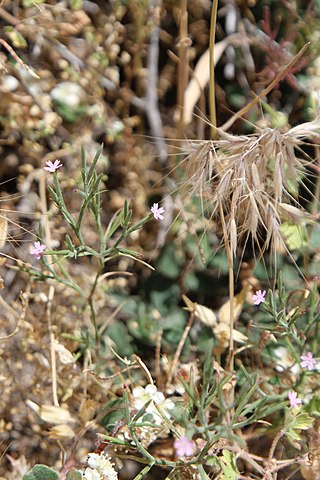
Ceanothus roderickii is a rare species of shrub in the family Rhamnaceae known by the common name Pine Hill ceanothus. It is endemic to western El Dorado County, California, where it grows in the chaparral and woodlands of the Sierra Nevada foothills, such as the Pine Hill Ecological Reserve. It is named after 20th century California flora explorer, botanist, and arboretum director Wayne Roderick.
Microseris acuminata is a species of flowering plant in the family Asteraceae known by the common name Sierra foothill silverpuffs. It is native to the Central Valley of California and the mountain ranges, including the Sierra Nevada, surrounding it. There is a disjunct occurrence in Jackson County, Oregon. The plant grows in grassy habitat, woodlands, and sometimes the edges of vernal pools.
Sabulina californica, commonly known as California sandwort, is a species of flowering plant in the family Caryophyllaceae.
Sabulina pusilla is a species of flowering plant in the family Caryophyllaceae known by the common names annual sandwort and dwarf stitchwort.

Sabulina stolonifera is a rare species of flowering plant in the pink family known by the common names Scott Mountain sandwort and stolon sandwort.

Monardella linoides is a species of flowering plant in the family Lamiaceae known by the common name flaxleaf monardella.

Penstemon azureus is a flowering plant species known by the common name azure penstemon. It is native to the mountains of Oregon and northern California. It grows in coniferous forests and woodlands in the Klamath Mountains, North California Coast Ranges, Southern Cascade Range, and Northern Sierra Nevada.

Penstemon centranthifolius is a species of penstemon known by the common name scarlet bugler. It is native to California and parts of Mexico, where it grows in many types of dry habitat from coast to desert, such as chaparral and oak woodland.

Torreyostellaria is a genus of flowering plants in the family Caryophyllaceae. It is monotypic, being represented by the single species Torreyostellaria jamesiana, commonly known as tuber starwort and sticky starwort, It is native to much of the western United States, where it can be found in sagebrush, coniferous forests, and many other types of habitat.

Silene bridgesii is a species of flowering plant in the family Caryophyllaceae known by the common name Bridges' catchfly.
Silene serpentinicola is a rare species of flowering plant in the family Caryophyllaceae known by the common name serpentine Indian pink and serpentine catchfly.

Silene invisa is a species of flowering plant in the family Caryophyllaceae known by the common names red fir catchfly and short-petaled campion.
Silene nuda is a species of flowering plant in the family Caryophyllaceae known by the common names western fringed catchfly and sticky catchfly.

Silene occidentalis is a species of flowering plant in the family Caryophyllaceae known by the common names western catchfly and western campion.

Engellaria obtusa is a species of flowering plant in the family Caryophyllaceae known by the common names Rocky Mountain chickweed, blunt-sepaled starwort, and obtuse starwort. It is the sole species in genus Engellaria. It is native to western North America, from British Columbia and Alberta to California to Colorado, where it grows in moist areas in forests and on mountain slopes.
Streptanthus fenestratus is an uncommon species of flowering plant in the mustard family known by the common name Tehipite Valley jewelflower.

Dianthus nudiflorus, synonym Velezia rigida, is a species of flowering plant in the family Caryophyllaceae. It is native to the Mediterranean Basin countries of Europe and North Africa, and to western and central Asia and Pakistan. It is also present in northern California where it is an introduced species. It is an annual herb growing from a taproot and producing a hairy, glandular, branching green or purplish stem up to 40 centimeters tall. The linear leaves are up to 2 centimeters long. Solitary flowers occur in the leaf axils. Each flower has a very long, cylindrical, ribbed calyx of fused sepals forming the tubular throat of the flower, measuring at least a centimeter in length. At the top of the tube is the flower corolla which has five pink or purplish petals.

Eremogone cliftoniii is a species of flowering plant in the family Caryophyllaceae known by the common name Clifton's eremogone. It is endemic to California, where it is known from 27 to 33 occurrences in Butte and Plumas Counties. It occurs in forests and chaparral habitat on weathered granite soils. Although limited in distribution it may be relatively abundant where it does occur. The plant was only described to science in 2007.
Sabulina cismontana is a species of flowering plant in the family Caryophyllaceae known by the common name cismontane minuartia.
Hartmaniella oxyphylla, the robust starwort or Robinson's starwort, is a rare species of plant endemic to the north-western United States, where it is known only from Kootenai and Shoshone Counties, Idaho. It grows along stream-banks in conifer forests at elevations of 800–900 m.












